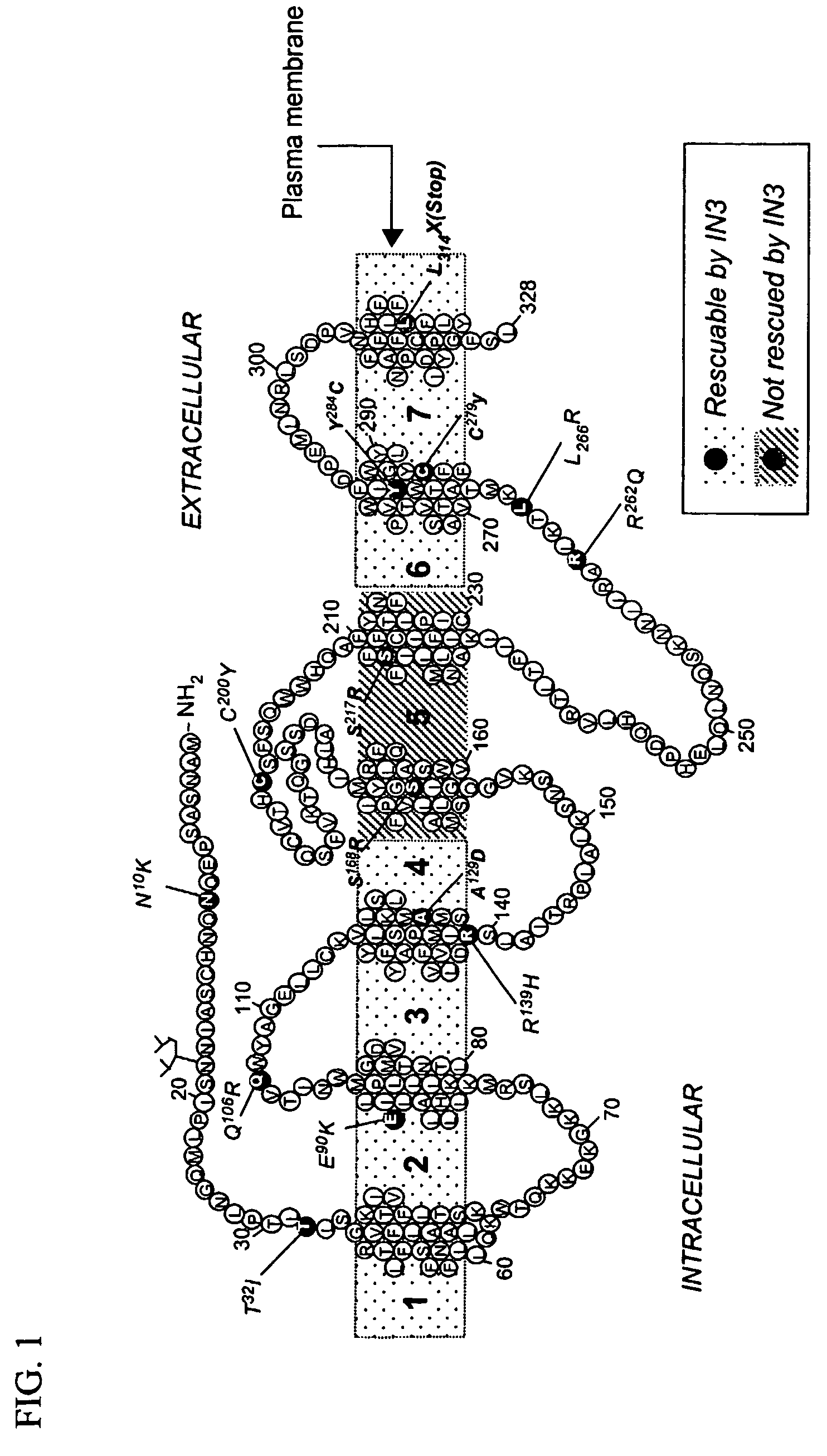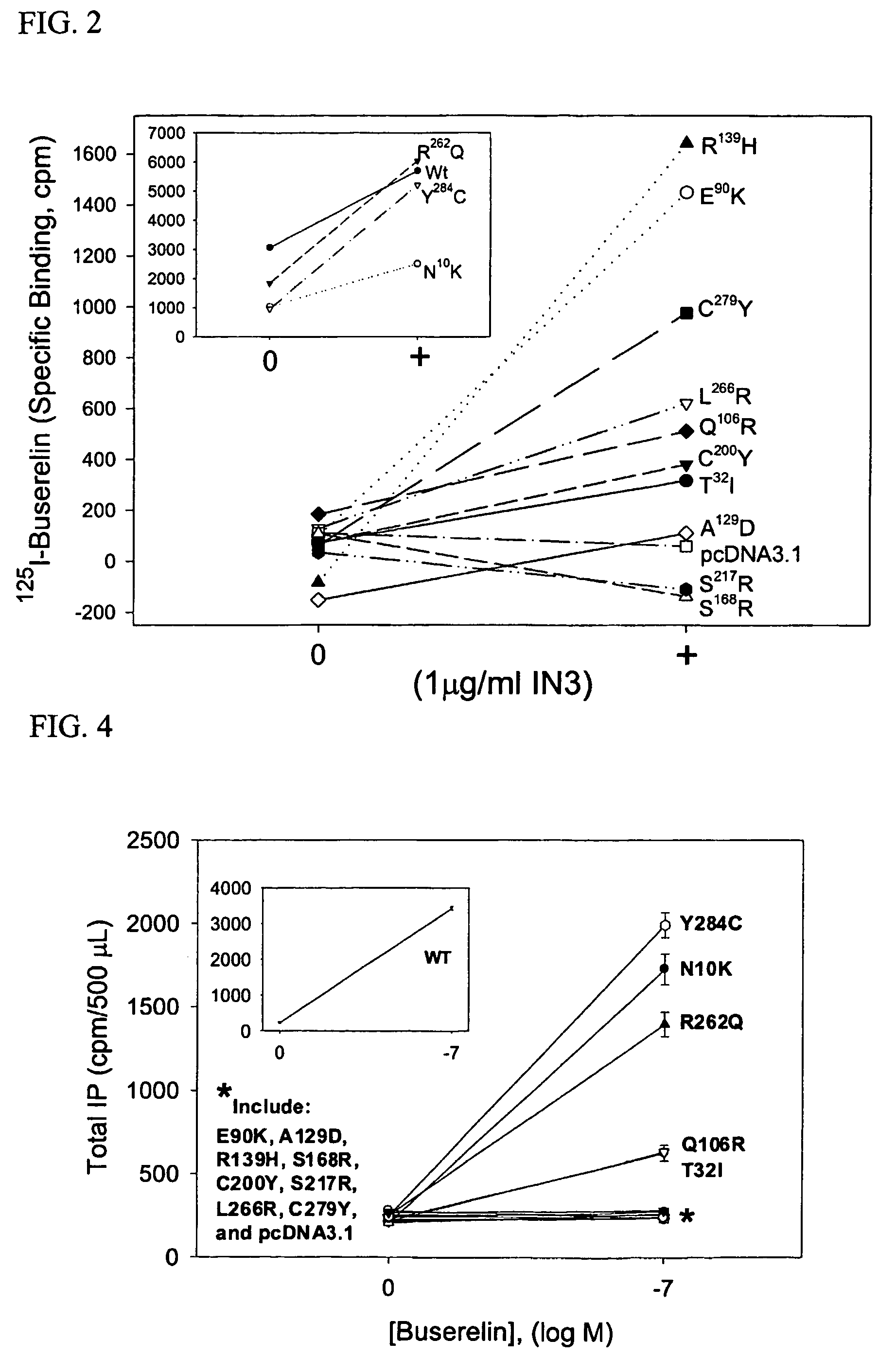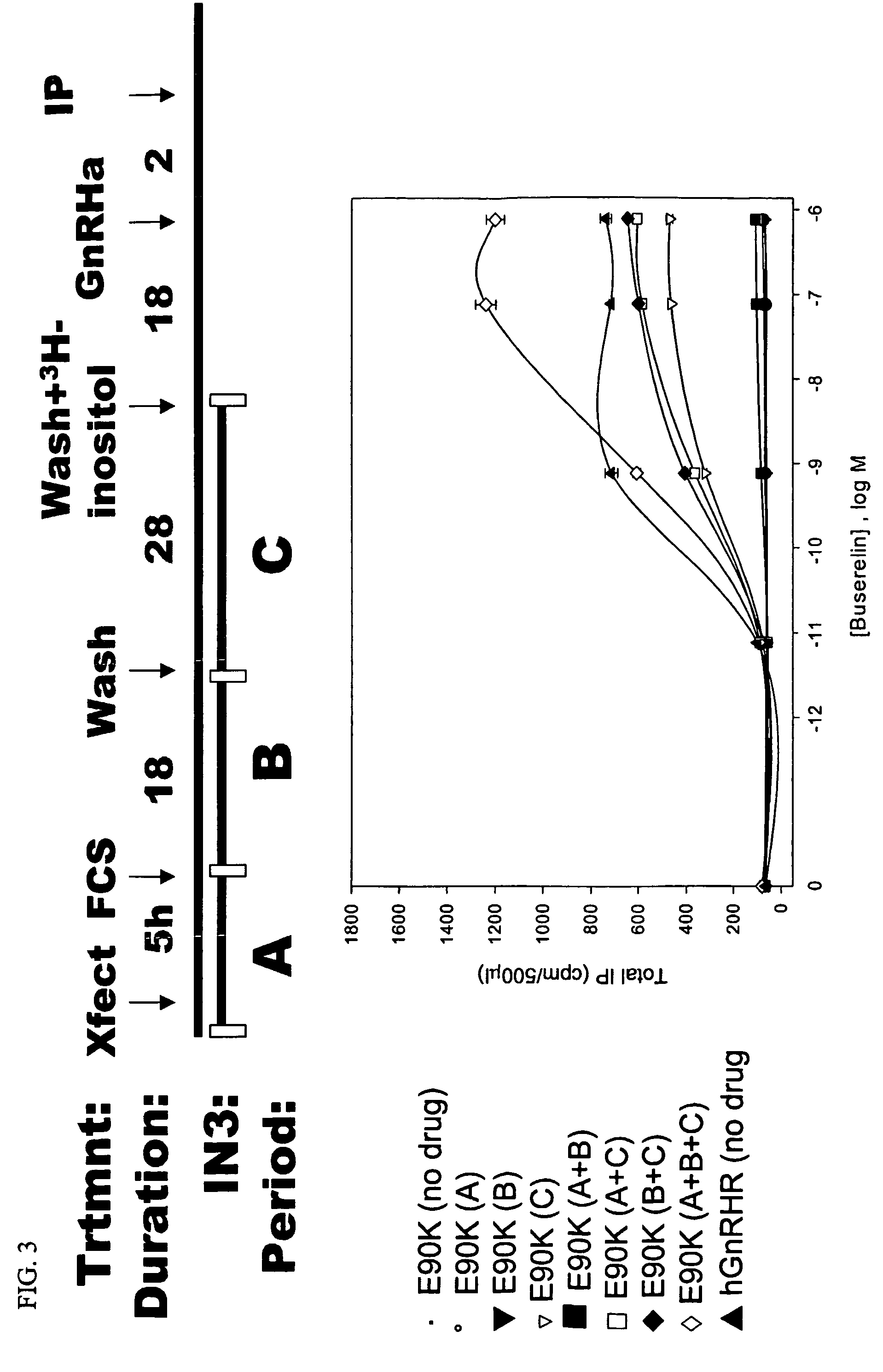Rescue of gonadotropin releasing hormone receptor mutants
a technology of releasing hormone and mutants, which is applied in the field of rescue of gonadotropin releasing hormone receptor mutants, can solve the problems of receptor not reaching the proper locus of protein, and achieve the effect of restoring function
- Summary
- Abstract
- Description
- Claims
- Application Information
AI Technical Summary
Benefits of technology
Problems solved by technology
Method used
Image
Examples
example 1
Saturation Binding of Wild-Type and Mutant GnRHR
[0046]FIG. 1 shows a representation of the human GnRH receptor indicating several loci of mutation which result in hypogonadotropic hypogonadism (HH). In addition, FIG. 1 shows the Lys191 found in human GnRHR, but not in preprimate species. It was previously shown that the E90K mutation itself, while resulting in protein misfolding, does not irreversibly destroy the intrinsic ability of the mutant receptor to bind ligand or to couple effector (Maya-Nudez et al., J. Clinical Endocrinol. Metab. 87:2144-9, 2002). To demonstrate that mutations in GnRHR result in misrouting of the mutant receptor within the cell, which can be rescued by addition of IN3, the methods below were used. IN3 [(2S)-2-[5-[2-(2-azabicyclo[2.2.2]oct-2-yl)-1,1-dimethyl-2-oxoethyl]-2-(3,5-dimethylphenyl)-1H-indol-3-yl]-N-(2-pyridin-4-ylethyl)propan-1-amine] is an indole previously designed as a peptidomimetic antagonist of GnRH by Merck Research Laboratories in Rahway,...
example 2
Inositol Phosphate Production of Wild-Type and Mutant GnRHR
[0051]To measure inositol phosphates (IP) production, methods described previously were used (Huckle and Conn, Methods Enzymol. 141:149-55, 1987). Briefly, 51 hours after the start of transfection with WT or mutant hGnHRH (as described in Example 1), transiently transfected COS-7 cells were washed twice with DMEM (no IN3) containing 0.1% bovine serum albumin (BSA), and intracellular inositol lipids were incubated in inositol-free DMEM supplemented with 4 μCi / ml [3H]myo-inositol for 18 hours at 37° C. (FIG. 3) (IN3 is no longer present). IN3 was included as indicated in FIG. 3 in single or multiple periods. When the drug was present in multiple periods, fresh IN3 was added at each period. After the preloading period, cells were washed twice with DMEM (inositol free) containing 5 mM LiCl (no IN3) and incubated for 2 hours at 37° C. in the absence or presence of the indicated doses of GnRH agonist buserelin (see Example 1 and F...
example 3
Specificity of a Rescued E90K hGnRHR Mutant
[0057]To compare the rescued mutant E90K receptor with WT GnRHR, ligand specificity and affinity, and receptor features associated with pharmacological disease management, were determined.
[0058]COS-7 cells were transfected with vector (0.1 μg cDNA / 105 cells; 2 μl Lipofectamine) as described in the above Examples, and treated with 1 μg / ml IN3 for periods A, B, and C (FIG. 3). The ability of the following agonists (FIG. 6), antagonists (FIG. 7), or irrelevant compounds (FIG. 6) to activate IP production was assessed using the methods described in Example 2: GnRH agonist leuprolide (D-Leu6, Pro9, des-Gly10-ethylamide-GnRH; TAP Pharmaceuticals, Deerfield, Ill.); GnRH antagonists (D-Phe2, D-Phe6GnRH, Wyeth-Ayerst Laboratories (Andover, Mass.); ‘Nal-Arg’ ([Ac-D-Nal1, D-Cpa2, D-Pal3, Arg5, D-Arg6, DAla10]-GnRH, Salk Institute); ‘Nal-Glu’ ([Ac-D-Nal1, D-Cpa2, D-3Pal3, Arg5, D-Glu6, D-Ala10]-GnRH, Salk Institute); cetrorelix (Peninsula Laboratories,...
PUM
| Property | Measurement | Unit |
|---|---|---|
| pH | aaaaa | aaaaa |
| size | aaaaa | aaaaa |
| size | aaaaa | aaaaa |
Abstract
Description
Claims
Application Information
 Login to View More
Login to View More - R&D
- Intellectual Property
- Life Sciences
- Materials
- Tech Scout
- Unparalleled Data Quality
- Higher Quality Content
- 60% Fewer Hallucinations
Browse by: Latest US Patents, China's latest patents, Technical Efficacy Thesaurus, Application Domain, Technology Topic, Popular Technical Reports.
© 2025 PatSnap. All rights reserved.Legal|Privacy policy|Modern Slavery Act Transparency Statement|Sitemap|About US| Contact US: help@patsnap.com



